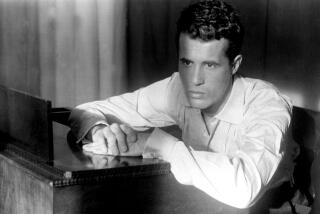Larger Than Life Even in Death
- Share via
All his life, Andre Malraux courted greatness. In 1996, 20 years after his death, he was accorded the French apotheosis of it. His remains were interred in the Pantheon to lie with those of Voltaire, Rousseau, Hugo and Zola.
But does he deserve to rest there? Or was he, as Simon Leys writes in the New York Review of Books, “essentially phony?” These are questions raised by Curtis Cate’s entertaining biography of this strange and complicated man.
Nearly everyone agrees that Malraux made a powerful impression.
“Never . . . have I ever had such a tactile impression of genius,” said a fellow fighter in the French underground on meeting Malraux during World War II.
But genius for what? He was by turns stock market speculator, publisher of pornography, novelist, adventurer, art historian, temple looter, leftist, Gaullist cabinet minister--a protean human being for whom the concept of metamorphosis had a mystical appeal.
Legends about Malraux, some of which he created, abounded. Cate, an American writer long resident in Paris, carefully extracts the truths of Malraux’s life from the fictional versions.
Malraux did not drop bombs on Gen. Franco’s forces by tossing them out of the windows of the airplanes in his volunteer squadron defending the Spanish republic. Nor did he escape from a German prison camp during World War II disguised as a carpenter and carrying two boards on his shoulder.
But he did organize his squadron, even though he couldn’t fly, and after his release from the prison camp and his move into the Resistance, he did put together a tank brigade against the Germans, even though he couldn’t drive.
Cate plausibly argues that in Malraux’s case “the lived reality is more fascinating than the hackneyed fiction.” The Malraux who emerges in Cate’s pages is more complex than the ecrivain engage, a writer with a political commitment, he is sometimes supposed to be.
Rather, Cate sees him as an intellectual “for whom action, service in a noble cause, and an anguished search for human significance in a godless cosmos were far more important than fiction.” He attributes to Malraux a Nietzschean belief in the value of action for its own sake.
Certainly, only a supremely self-confident person, scornful of the rules that apply to ordinary men, would have dreamed up the scheme whereby Malraux hoped to make his fortune. Using what was left of his young wife’s money, he would dismantle and sell an obscure Khmer temple in Cambodia, then under French rule.
Caught before the couple left Indochina, Malraux was sentenced to three years’ confinement. Released with the help of friends in Paris, he returned to Indochina and founded a newspaper, in which he attacked the corrupt French colonial regime.
With the paper, Malraux began building his reputation as a fighter for the oppressed and an ardent opponent of fascism. He enhanced this image with his novel “La Condition humaine” (“Man’s Fate”), about a revolution in Canton, China, which he had never seen. Later, he published the novel “L’Espoir,” (“Man’s Hope”) about the Spanish Civil War, which he had seen.
These novels, and his others, were written in intense telegraphic prose that leaps from scene to scene.
They are not unlike his famous conversations, which moved from subject to subject with a speed that left his listeners dazzled, or perhaps frazzled. Andre Gide once remarked that he had encountered Malraux “speaking four times too fast, four times too intelligently.”
As I read Cate, what we have left is a life of grand gestures.
More to Read
Sign up for our Book Club newsletter
Get the latest news, events and more from the Los Angeles Times Book Club, and help us get L.A. reading and talking.
You may occasionally receive promotional content from the Los Angeles Times.






